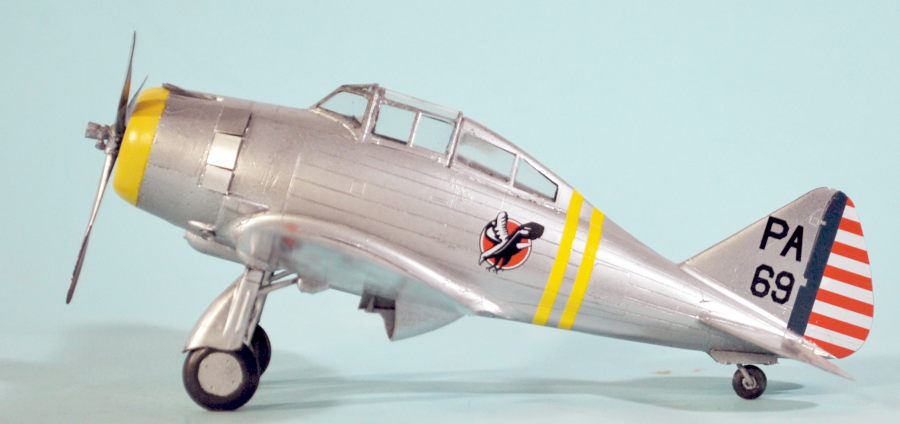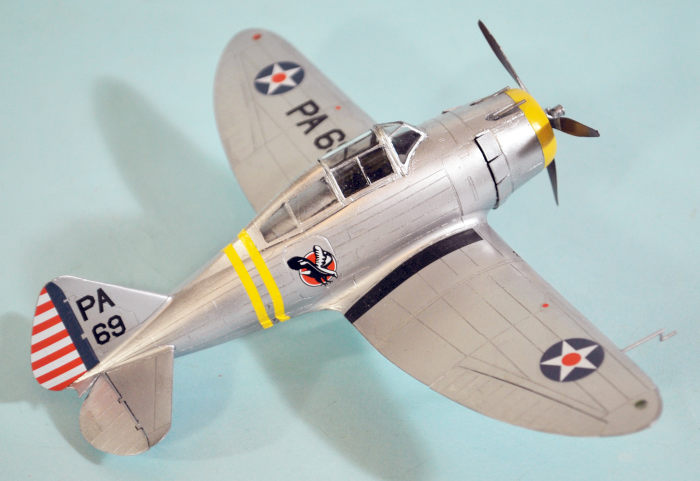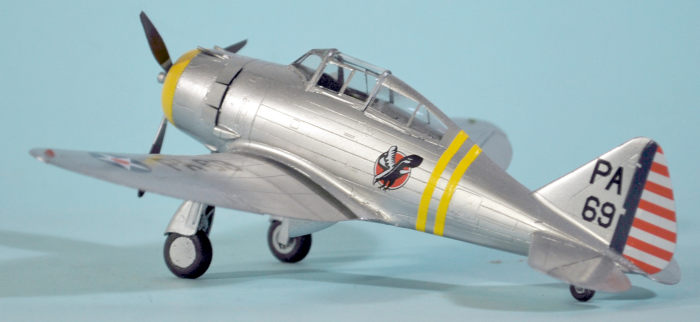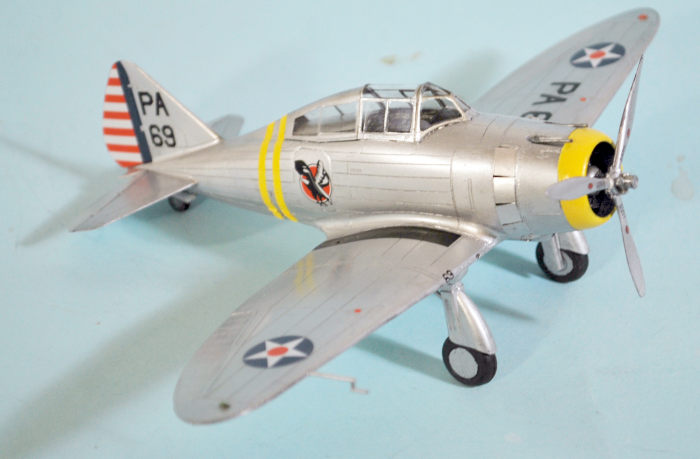
| KIT #: | DW 48012 |
| PRICE: | $59.95 |
| DECALS: | Three options |
| REVIEWER: | Tom Cleaver |
| NOTES: | Short run |

| HISTORY |
The P-35 was a military development of the Seversky SEV-3 three- seat amphibian, designed by Alexander Kartveli, Seversky's chief designer and was Alexander P. de Seversky's first aircraft. The SEV-3 flew in June 1933 and was developed into the Seversky BT-8 basic trainer, of which 30 were ordered by the Army Air Corps in 1935. It proved manifestly underpowered and was quickly replaced by the North American BT-9.
 The
second prototype SEV-3 was completed as a two-seat fighter, the SEV-2XP, powered
by a 735 hp R-1820 Cyclone with fixed landing gear in aerodynamic spats.When the
Air Corps announced a competition for a new single-seat fighter in 1935,
Seversky sent the SEV-2XP, expecting it to win despite being a two-seater.
However, the aircraft was damaged on 18 June 1935 during its transit to the
fly-offs at Wright Field; some people think this was intentional, since Seversky
had in the meantime learned about the Curtiss Model 75, which was a single-seater
with retractable undercarriage, The competition was delayed while Seversky was
allowed to “rebuild” the aircraft into the virtually-new SEV-1XP, a single
seater with a retractable undercarriage and a more powerful 850 hp R-1820-G5
replacing the SEV-2XP’s engine. The SEV-1XP arrived at Wright Field on August 15
for a successful evaluation, though the Cyclone failed to deliver its rated
power and the SEV-1XP only reached 289 mph not the 300 mph advertised by
Seversky.
The
second prototype SEV-3 was completed as a two-seat fighter, the SEV-2XP, powered
by a 735 hp R-1820 Cyclone with fixed landing gear in aerodynamic spats.When the
Air Corps announced a competition for a new single-seat fighter in 1935,
Seversky sent the SEV-2XP, expecting it to win despite being a two-seater.
However, the aircraft was damaged on 18 June 1935 during its transit to the
fly-offs at Wright Field; some people think this was intentional, since Seversky
had in the meantime learned about the Curtiss Model 75, which was a single-seater
with retractable undercarriage, The competition was delayed while Seversky was
allowed to “rebuild” the aircraft into the virtually-new SEV-1XP, a single
seater with a retractable undercarriage and a more powerful 850 hp R-1820-G5
replacing the SEV-2XP’s engine. The SEV-1XP arrived at Wright Field on August 15
for a successful evaluation, though the Cyclone failed to deliver its rated
power and the SEV-1XP only reached 289 mph not the 300 mph advertised by
Seversky.
Protests from Curtiss delayed the formal flyoff between the two competitors until April 1936, with both Seversky and Curtiss taking the opportunity to improve their aircraft; in the meantime Vought entered the V-141 while Consolidated came up with a single seat version of the PB-2. The SEV-1XP now had a Pratt & Whitney R-1830-9 "Twin Wasp" and a modified vertical stabilizer and was now the SEV-7.
 The
new engine also failed to deliver its rated power only reaching 738 hp and top
speed was again well below 300 mph. While the SEV-7 was more expensive than
either Curtiss’ or Vought’s entries it won the competition and received an order
for 77 P-35 fighters and spare parts equal to eight airplanes on June 16, 1936
at a cost of $1,636,250.
The
new engine also failed to deliver its rated power only reaching 738 hp and top
speed was again well below 300 mph. While the SEV-7 was more expensive than
either Curtiss’ or Vought’s entries it won the competition and received an order
for 77 P-35 fighters and spare parts equal to eight airplanes on June 16, 1936
at a cost of $1,636,250.
The first production P-35 was delivered in May 1937, and delivery of 76 was completed in August 1938. Unhappy with Seversky’s slow delivery of the P-35 and sale of 2PA two-seat fighters to the Japanese Navy, the Air Corps ordered 210 Curtiss P-36s that summer.
Seversky continued to develop the design with the hope of selling more to the Air Corps and export customers. The SEV-1XP was turned into a single seat racer, the S-1, which took 4th place in the 1937 Bendix Trophy race, in which the S-2, a similar aircraft built for Frank Fuller took first place. The S-2 also won the Bendix in 1939, placed second in 1938, and portrayed the "Drake Bullet" in the 1938 film “Test Pilot.”
| THE KIT |
 Hobbycraft
made a P-35, P-35A and Seversky racer in the early 1990s, which were, until the
release of this P-35 kit by Dora Wings and their J-9/P-35A, the only 1/48
plastic kits of the Seversky fighters available. The kits were not Hobbycraft’s
best, and this kit, which is thoroughly accurate and very well-detailed, turns
them into the doorstops they have aspired to be for 30 years. Other P-35 and
P-35A kits have been released in 1/72 by Special Hobby. Special Hobby’s 1/72
kits are accurate, though they are not easy.
Hobbycraft
made a P-35, P-35A and Seversky racer in the early 1990s, which were, until the
release of this P-35 kit by Dora Wings and their J-9/P-35A, the only 1/48
plastic kits of the Seversky fighters available. The kits were not Hobbycraft’s
best, and this kit, which is thoroughly accurate and very well-detailed, turns
them into the doorstops they have aspired to be for 30 years. Other P-35 and
P-35A kits have been released in 1/72 by Special Hobby. Special Hobby’s 1/72
kits are accurate, though they are not easy.
This kit differs from the previously-released J-9/P-35A in having the shorter fuselage of the P-35 and other detail difference such as the mounting of the machine guns in the nose. Decals are provided for P-35s flown by squadrons of the First Pursuit Group at Selfridge Field, 1938-40. The clear sanopy is provided in sections but can only be accurately assembled in the closed position.
| CONSTRUCTION |
Like the MB 152, this is a “high-end/limited-run kit.” Pay attention to the latter and you will achieve the former. The instructions are very good and I had no trouble in assembly by committing the radical act of actually paying attention to the instructions. I used kit parts only, other than Eduard pre-war US lap belts. Do not use a shoulder harness with this model, because US military aircraft before World War II were equipped only with lap belts.
 With
care in cleaning up parts, the model assembles nicely if you take your time and
test fit test fit test fit. I had to trim the elevators so they would fit to the
horizontal stabilizer so I could droop them, sanding off just a bit of the inner
edge to get things to open up enough to move them. The engine took some fiddling
and I ended up using Evergreen rod for details since the parts are really
fragile and getting some of them off the sprue is close to impossible.
With
care in cleaning up parts, the model assembles nicely if you take your time and
test fit test fit test fit. I had to trim the elevators so they would fit to the
horizontal stabilizer so I could droop them, sanding off just a bit of the inner
edge to get things to open up enough to move them. The engine took some fiddling
and I ended up using Evergreen rod for details since the parts are really
fragile and getting some of them off the sprue is close to impossible.
Be sure to put that baggage compartment door in place *before* attaching the fuselage halves together, because you have to trim it to fit and you want to be able to work it from both sides to get it to fit right. The wing and fuselage sub-assemblies fit nicely. I rubber banded the wing around the tips to bring it in tight against the upper fuselage joint. When it set, all was in proper position and I didn’t have to use any filler.
| COLORS & MARKINGS |
 I
used the kit-supplied masks for the canopy. I gave the model an overall coat of
Tamiya X-1 Gloss Black, thinned 50-50, for a primer coat then airbrushed Vallejo
Aluminum overall. I painted the fabric control surfaces with Vallejo White
Aluminum.
I
used the kit-supplied masks for the canopy. I gave the model an overall coat of
Tamiya X-1 Gloss Black, thinned 50-50, for a primer coat then airbrushed Vallejo
Aluminum overall. I painted the fabric control surfaces with Vallejo White
Aluminum.
I used the kit decals to do the airplane of the squadron commander of the 27th Pursuit Squadron of the 1st Pursuit Group. The kit decals are printed in Ukraine and are first-rate, melting into the surface detail with an application of Micro-Sol.
I assembled the landing gear and attached it, then attached the prop and the pitot tube.
| CONCLUSIONS |
This kit thoroughly eclipses the Hobbycraft kits. It is accurate, and easy to assemble if you take your time and clean all the parts thoroughly. The result is a really first-rate addition to my Golden Age of Aviation model collection. Highly recommended to modelers experienced with limited-run kits.
13 January 2022
Copyright ModelingMadness.com. All rights reserved. No reproduction in part or in whole without express permission.
Thanks to Dora Wings for the Review Kit.
If you would like your product reviewed fairly and fairly quickly, please contact the editor or see other details in the Note to Contributors.